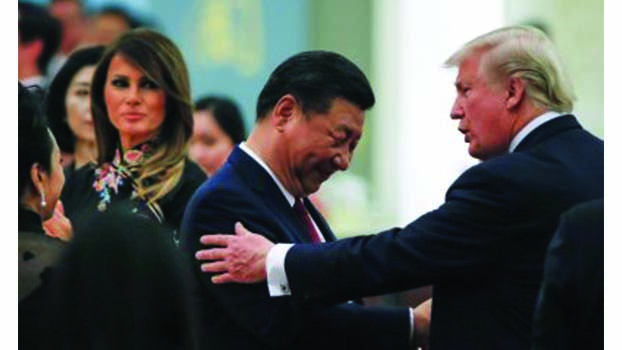The pains of a prolonged US–China trade war

Yuhan Zhang
Reality once again demonstrates that in a trade war surplus countries like China hold a disadvantage against those with deficits such as the United States. But with little to show for its efforts, it is not in the best interests of the United States to fight with China. The best option for both sides is to reach an agreement.
US President Donald Trump’s trade war has not achieved its original objectives. First, the US total current account deficits will remain massive this year. The politically sensitive goods trade deficit with China in the first half of 2019 registered US$167 billion. Second, the trade war has failed to impede China’s technological enhancement. Despite the Chinese government and media renouncing the slogan ‘Made in China 2025’, China continued boosting investment and innovation in the strategic industries listed under the initiative. Geo-economic factors are also intensifying downside risks to the US macroeconomic outlook, as shown by the recent economic indicators.
But China still has more palpable losses. US tariffs have slowed China’s GDP by an estimated 0.6 per cent. The trade war also affects GDP through indirect channels. It has driven dozens of firms to shift their supply chains from China to ASEAN countries and deterred Chinese investment in the United States. Chinese global investment is decreasing, but investment in the United States has shrunk more significantly from US$24 billion in 2017 to US$9 billion in 2018 and US$3.2 billion in 2019.
China is shifting its strategic focus to the Belt and Road Initiative, particularly in Russia and Southeast Asian countries. The growth rate of foreign direct investment into China has also decreased from a growth rate of 7.9 per cent in 2017 to 0.9 per cent in 2018. But China still needs to attract US investment in order to attain the advanced technology, talent, business, and managerial expertise to become a manufacturing power — a national goal that China’s top leadership has promoted. The total impact of the trade war might shrink China’s GDP by at least 1 per cent.
Even without the trade war, China faces intimidating domestic challenges. Economic structural change is progressing slowly. China’s gross savings rate remains above 45 per cent. Continued high savings have driven Chinese investment, sustaining it at 44.8 per cent of GDP. This prolonged large-scale investment is producing mounting debt.
Between 2015 and 2018, non-performing loans (NPLs) in Chinese commercial banks increased from less than 1 trillion yuan (US$140 billion) to 2.03 trillion yuan (US$284 billion). NPLs of non-bank financial institutions and industrial companies have also accumulated in recent years. The accounts receivable of Chinese above-scale industrial companies — which may easily morph into NPLs — reached 14.3 trillion yuan (US$2 trillion) in 2018, 8.6 per cent higher than 2017 levels.
Worse still, many households finance their spending by borrowing. Chinese household debt has exploded in the past 5 to 6 years. Household debt as a percentage of GDP has increased 20 per cent to 53.2 per cent, fuelling worries that the burden of debt servicing could put a drag on long-term economic growth.
Opening up China’s financial services sector and
allowing foreign investors to buy Chinese bonds
are one way to help achieve the strategy.
But China needs more serious reforms to
create a deep, liquid and stable financial
market at home. It still has a long way to go
Amid the trade war and economic slowdown, the Chinese government has initiated tax cuts and implemented monetary measures to prevent a deeper slump. Night time consumption is encouraged in large cities to drive growth. Local governments have required stores, restaurants, and tourist attractions to extend their business hours. The China National Tourism Administration estimates that night time consumption will contribute an additional 600 billion yuan (US$84 billion) (0.6 per cent) to China’s GDP. In order to stabilise the growth rate above 6 per cent this year, the government might make further investments in infrastructure. China can also rely on monetary tools such as interest rates and reserve ratio requirements.
These initiatives may support China’s economic growth in the short and medium term, but the most sustainable option is to transform China into a normal consumer society. A recent People’s Bank of China survey of 18,600 residents from 31 provinces shows income constraints and a preference for saving money inhibits people’s willingness to spend. A shift from saving to consumption can be reinforced by improving the social safety net and dramatically increasing the household share of national income.
To respond to Trump’s pressure, renminbi internationalisation is being strongly advocated by senior officials in China. Chen Yuan, the former Chairman of China Development Bank, mentioned three ways to do this in August 2019 — support and promote a more market-oriented and flexible renminbi with measured controls, increase the renminbi’s international expansion and penetration, and reduce the renminbi’s dependence on the US dollar.
Opening up China’s financial services sector and allowing foreign investors to buy Chinese bonds are one way to help achieve the strategy. But China needs more serious reforms to create a deep, liquid and stable financial market at home. It still has a long way to go.
The trade war brings no benefits to the United States and inflicts even more pain on China. It is high time for both China and the United States to seriously consider a truce and a true agreement — something the whole world is hoping for.
Yuhan Zhang is an economist and independent researcher



